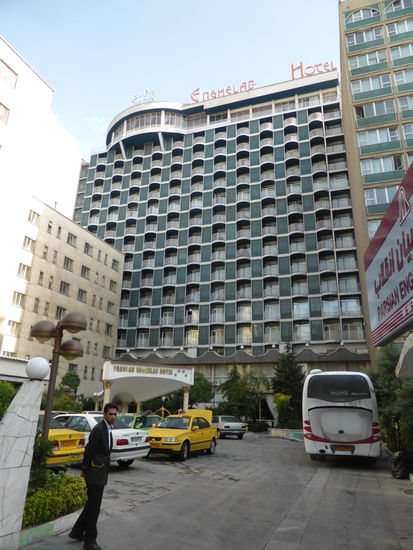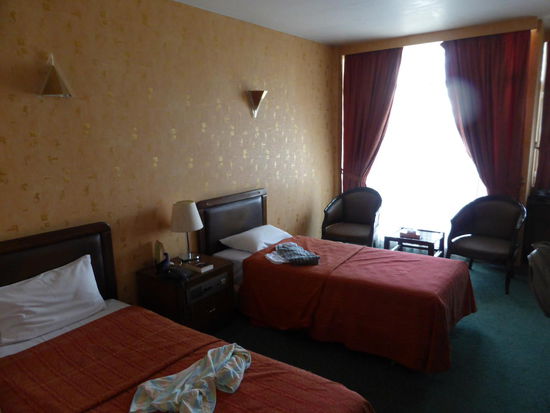Achämeniden, Safawiden und Sassaniden
Hinflug mit Iran-Air
Da das online-ticketing für rail&fly geklappt hat, brauchen wir am Bahnhof nicht mehr am Automaten experimentieren, nachdem uns Ricky abgesetzt hat. Pünktlich um 7.40 Uhr fährt der ICE11 ab und ist ebenso pünktlich um 9.26 Uhr am Frankfurter Flughafen. Auch das einchecken geht zügig und Ulrike wundert sich, dass auf dem Hinflug 45 kg Gepäck zugelassen sind. Die Erklärung ist , dass die 'fliegenden' Perser ganze Ladungen von Haushaltsgeräten mitschleppen, wohl weil es dies zu Hause nicht gibt (Embargo). Nachdem wir die Paßkontrolle hinter uns gelassen haben, wollen wir einen Kaffee trinken . Doch hinter der Paßkontrolle kommt nichts mehr an C6. Es handelt sich nämlich wohl um den Teminal für El AL, wo die Sicherheitskontrolle von anderen getrennt stattfindet. Also heißt es warten. Eine nette Perserin mit Kind und ein persischer Maschinenbauer mit Studium in Aachen verkürzen uns die Wartezeit. Der Perser erzählt uns, dass der als Direktflug ausgewiesene Flug auf dem Flug nach Iran immer zum Tanken in Belgrad zwischenlandet. (wegen des Embargos erhält Iranair in Frankfurt kein Kerosin) Um 12.00 Uhr ist die Maschine startklar, alle Passagiere an Bord, der Flug ist längst nicht ausgebucht. Start um 12.30 Uhr. Bald gibt es Frühstück mit Osaft, Kaffee und Kuchen mit Keks. Um 14 Uhr landen wir dann zum Tanken in Belgrad auf einem winzigen Airport. Weiterflug um 15 Uhr. Wider Erwarten gibt es dann um 15.30 Uhr Mittagessen. Ich bin erstaunt, dass es Cola, Fanta, Sprite gibt, wo dies doch amerikanische Marken sind. wir entscheiden uns jedoch für das iranische Delsterbier 'Lemon' ; Ulrike schmeckt es nicht, bei mir stellt sich der Genuß von Alsterwasser ein. Ankunft in Teheran um 21.10 Uhr Ortszeit (2,5! Stunden vorstellen)
Dann beginnt die Warterei - Chaos am Paßschalter fūr Foreigner; nebenan gibt es fast eine Schlägerei. Inzwischen haben wir unsere Mitfahrer schon kennengelernt. Sie sind vor uns draußen und haben unseren Reiseleiter schon gefunden, derweil wir noch unsere Koffer am Band abholen müssen. Sie sind inzwischen die letzten, die noch mit dem Band rundlaufen. Dafür winkt der Zollbeamte und durch und wir müssen unsere Koffer nicht durchleuchten lassen. Sami stellt sich vor und bringt uns mit einem Kleinbus nicht ins vorgesehene Babat Taher Hotel sondern ins Engehlab), das auch für die letzte Nacht vorgesehen ist. In Teheran hat es ein schweres Gewitter gegeben und an manchen Stellen steht das Wasser noch am Straßenrand. Während Sami eincheckt, werden wir mit Osaft begrüßt. Ein Bier wäre uns natürlich lieber gewesen, aber das müssen wir uns unserer Leber zuliebe nun 3 Wochen abschminken. Um 23.30 Uhr sind wir endlich auf dem Zimmer und machen Nachtruhe.
zum Einstimmen:
aus: Tehran Times 29 April 2013
Iranians, pioneers of Persian Gulf navigation
The Persians made themselves important in world history with the establishment of the Achaemenid Empire in the sixth century BCE. Their rise and center of power was from the province of Fars (Pars/ Persis) in the southwestern region of the Iranian plateau. Consequently in the Greek sources, the body of water that bordered this province came to be known as the Persian Gulf. The use of ethnic names for bodies of water certainly presumes either that group's dominance of the landmass or its seafaring activity. For the Persian Gulf, both are true. The Persian Gulf, however, has been less studied in terms of its economic importance and as a unit before the eighth century CE than other bodies of water.
Persian Gulf is a crescent-shape groove formed by the encroachment of Indian Ocean waters over a length of 900 km and width of 240 km. It has been a valuable international waterway since the beginning of history and as the cradle of great civilizations of the ancient East, it has a background of several millenniums, Cais-soas.com reported.
Iran designated April 30 as the National Persian Gulf Day to highlight the fact that the waterway has been referred to by historians and ancient texts as 'Persian' since the Achaemenid Empire was established in what is now modern day Iran. The Day marks the anniversary of the expulsion of Portuguese military forces from the Strait of Hormoz in 1622.
A brief history
Since centuries ago, the Elamites used the Port of Bushehr and Kharg Island for dwelling, shipping and ruling over the coasts of Persian Gulf as well as transaction with the West Indies and the Nile Valley.
Prior to the inhabitation of Aryan Iranians around 1000 to 1500 BCE, the Assyrians named the sea in their inscriptions as the "bitter sea" and this is the oldest name used for the Persian Gulf. An inscription of Darius the Great found in Suez Canal used the phrase "Sea of Pars" that points to the same Persian Gulf.
The Greek historian Herodotus in his book -History of Herodotus, 440 BCE- has repeatedly referred to the Red Sea as the "Arab Gulf".
Straben, the Greek historian of the second half of the first century BCE and the first half of the first century AD wrote: Arabs are living between the Arabian Gulf and the Persian Gulf.
Ptolemy, another renowned Greek geographer of the 2nd century has referred to the Red Sea as the "Arabicus Sinus", i.e. the Arabian Gulf. In the book `the world boundaries from the East to the West' which was written in the 4th century Hegira, the Red Sea was dubbed as the Arabian Gulf.
Today, the most common Arabic works refer to the sea in south Iran as the "Persian Gulf", including the world famous Arabic encyclopaedia `Al-Monjad' which is the most reliable source in this respect.
There are undeniable legal evidences and documents in confirmation of the genuineness of the term Persian Gulf. From 1507 to 1560 in all the agreements that Portuguese, Spanish, British, Dutch, French and Germans concluded with the Iranian government or in any other political event everywhere there is a mention of the name Persian Gulf.
Even in agreements with the participation of Arabs there is a mention of "Al-Khalij al-Farsi" in the Arabic texts and "Persian Gulf" in English texts, such as the document for the independence of Kuwait which was signed between the emir of Kuwait and representatives of the British government in the Persian Gulf.
The document, which was signed on June 19, 1961 by Abdullah As-Salem As-Sabah, has been registered in the Secretariat of the United Nations according to article 102 of the UN Charter and can be invoked at any UN office.
Since the beginning of the 20th century, the name "Persian Gulf" has been used in geography and history books with less reference to the "Fars Sea". Such a change has suggested the idea that the "Fars Sea" had been an old name substituted by a new term "Persian Gulf".
The beginning of 1930s was a turning point in the history of efforts for changing the name of Persian Gulf when Sir Charles Bellgrave, the British diplomatic envoy in Bahrain opened a file for the change in the name of the Persian Gulf and proposed the issue to the British Foreign Office. Even before the response of the British Foreign Office he used the fake name (in an attempt to retake Bahrain, the Tonbs, Abu Mosa, Sirri, Qeshm, Hengam and other islands belonging to Iran and to disclose and thwart the plot of disintegration of Khozestan).
Besides all the disputes that have been made over the name of the Persian Gulf, the United Nations with its 22 Arab member countries has on two occasions officially declared the unalterable name of the sea between Iran and the Arabian Peninsula as the Persian Gulf. The first announcement was made through the document UNAD, 311/Qen on March 5, 1971 and the second was UNLA 45.8.2 (C) on August 10, 1984. Moreover, the annual UN conference for coordination on the geographical names has emphatically repeated the name "Persian Gulf" each year.
Although using the "Arabian Gulf" instead of the "Persian Gulf" has no basis and will not be accepted in any culture or language, however, it will not diminish our responsibility in expressing the reality and eliminating ambiguities as the main and oldest inhabitants of the region.
(Source: Iran Chamber Society)
| Aufbruch: | 24.05.2014 |
| Dauer: | 3 Wochen |
| Heimkehr: | 14.06.2014 |


